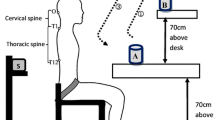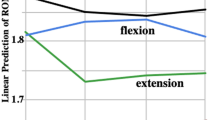Abstract
Muscle co-contraction is important in stabilizing the spine. The effects of movement speed and direction on the cervical co-contraction were, however, not yet investigated. Surface electromyographies of three paired cervical muscles were measured in 17 young healthy subjects. The subjects performed voluntary neck movements in sagittal and coronal plane at fast, medium, and slow speeds. The co-contraction ratio was defined as the normalized integration of antagonistic electromyographic activities divided by that of total muscle activities. The results showed that the co-contraction ratio at fast speed (0.42 ± 0.21) was smaller than that at medium (0.45 ± 0.20) and slow (0.46 ± 0.19) speeds (P ≤ 0.001). The co-contraction ratio was different between flexion and extension, but was similar between left and right lateral bending. The implications of co-contraction patterns include: (1) agonistic activities increase with speed but antagonistic activities do not increase accordingly; (2) neck extensors are highly activated during sagittal motions; and (3) muscular activations are symmetric during coronal motions. In conclusion, the co-contraction patterns from young healthy subjects demonstrate normal neuromuscular control in regulating the stiffness of cervical spine, and may further be references to assess the neck disorders in elderly or patients.



Similar content being viewed by others
Abbreviations
- SCM:
-
Sternocleidomastoid; flex and laterally flex the neck
- SPL:
-
Splenius capitis; extend and laterally flex the neck
- SSC:
-
Semispinalis capitis; extend and laterally flex the neck
- LLB:
-
Left lateral bending; from right end to left end position
- RLB:
-
Right lateral bending; from left end to right end position
- NAIEMG:
-
Normalized average integration of electromyographic activity
- CCR:
-
Co-contraction ratio
References
Armstrong B, McNair P, Taylor D (2008) Head and neck position sense. Sports Med 38:101–117
Bazzucchi I, Sbriccoli P, Marzattinocci G, Felici F (2006) Coactivation of the elbow antagonist muscles is not affected by the speed of movement in isokinetic exercise. Muscle Nerve 33:191–199
Carpentier A, Duchateau J, Hainaut K (1996) Velocity-dependent muscle strategy during plantarflexion in humans. J Electromyogr Kinesiol 6:225–233
Choi H (2003) Quantitative assessment of co-contraction in cervical musculature. Med Eng Phys 25:133–140
Cholewicki J, McGill SM (1996) Mechanical stability of the in vivo lumbar spine: implications for injury and chronic low back pain. Clin Biomech (Bristol, Avon) 11:1–15
Clancy EA, Morin EL, Merletti R (2002) Sampling, noise-reduction and amplitude estimation issues in surface electromyography. J Electromyogr Kinesiol 12:1–16
Crisco JJ 3rd, Panjabi MM (1991) The intersegmental and multisegmental muscles of the lumbar spine. A biomechanical model comparing lateral stabilizing potential. Spine 16:793–799
Crisco JJ, 3rd, Panjabi MM, Yamamoto I, Oxland TR (1992) Euler stability of the human ligamentous lumbar spine. Part 2: experimental. Clin Biomech (Bristol, Avon) 7: 27–32
Croce RV, Miller JP (2003) The effect of movement velocity and movement pattern on the reciprocal co-activation of the hamstrings. Electromyogr Clin Neurophysiol 43:451–458
Ebadzadeh M, Tondu B, Darlot C (2005) Computation of inverse functions in a model of cerebellar and reflex pathways allows to control a mobile mechanical segment. Neuroscience 133:29–49
Falla D, Dall’Alba P, Rainoldi A, Merletti R, Jull G (2002) Location of innervation zones of sternocleidomastoid and scalene muscles—a basis for clinical and research electromyography applications. Clin Neurophysiol 113:57–63
Falla D, Jull G, Hodges PW (2004a) Feedforward activity of the cervical flexor muscles during voluntary arm movements is delayed in chronic neck pain. Exp Brain Res 157:43–48
Falla DL, Jull GA, Hodges PW (2004b) Patients with neck pain demonstrate reduced electromyographic activity of the deep cervical flexor muscles during performance of the craniocervical flexion test. Spine 29:2108–2114
Falla D, Farina D, Dahl MK, Graven-Nielsen T (2007) Muscle pain induces task-dependent changes in cervical agonist/antagonist activity. J Appl Physiol 102:601–609
Gabriel DA, Matsumoto JY, Davis DH, Currier BL, An KN (2004) Multidirectional neck strength and electromyographic activity for normal controls. Clin Biomech (Bristol, Avon) 19:653–658
Gabriel DA, Kamen G, Frost G (2006) Neural adaptations to resistive exercise: mechanisms and recommendations for training practices. Sports Med 36:133–149
Granata KP, Marras WS (1995) The influence of trunk muscle coactivity on dynamic spinal loads. Spine 20:913–919
Granata KP, Orishimo KF (2001) Response of trunk muscle coactivation to changes in spinal stability. J Biomech 34:1117–1123
Granata KP, Lee PE, Franklin TC (2005) Co-contraction recruitment and spinal load during isometric trunk flexion and extension. Clin Biomech (Bristol, Avon) 20:1029–1037
Grandjean HE, Maeda K (1980) Constrained postures in accounting machine operators. Appl Ergon 11:145–149
Gribble PL, Mullin LI, Cothros N, Mattar A (2003) Role of cocontraction in arm movement accuracy. J Neurophysiol 89:2396–2405
Guez M, Hildingsson C, Nilsson M, Toolanen G (2002) The prevalence of neck pain: a population-based study from northern Sweden. Acta Orthop Scand 73:455–459
Hammond MC, Fitts SS, Kraft GH, Nutter PB, Trotter MJ, Robinson LM (1988) Co-contraction in the hemiparetic forearm: quantitative EMG evaluation. Arch Phys Med Rehabil 69:348–351
Harms-Ringdahl K, Ekholm J (1986) Intensity and character of pain and muscular activity levels elicited by maintained extreme flexion position of the lower-cervical-upper-thoracic spine. Scand J Rehabil Med 18:117–126
Hermens HJ, Freriks B, Disselhorst-Klug C, Rau G (2000) Development of recommendations for SEMG sensors and sensor placement procedures. J Electromyogr Kinesiol 10:361–374
Hubley-Kozey C, Earl EM (2000) Coactivation of the ankle musculature during maximal isokinetic dorsiflexion at different angular velocities. Eur J Appl Physiol 82:289–296
Joines SM, Sommerich CM, Mirka GA, Wilson JR, Moon SD (2006) Low-level exertions of the neck musculature: a study of research methods. J Electromyogr Kinesiol 16:485–497
Jordan A, Mehlsen J, Bulow PM, Ostergaard K, Danneskiold-Samsoe B (1999) Maximal isometric strength of the cervical musculature in 100 healthy volunteers. Spine 24:1343–1348
Klass M, Baudry S, Duchateau J (2005) Aging does not affect voluntary activation of the ankle dorsiflexors during isometric, concentric, and eccentric contractions. J Appl Physiol 99:31–38
Klein CS, Rice CL, Marsh GD (2001) Normalized force, activation, and coactivation in the arm muscles of young and old men. J Appl Physiol 91:1341–1349
Lantz CA, Klein G, Chen J, Mannion A, Solinger AB, Dvorak J (2003) A reassessment of normal cervical range of motion. Spine 28:1249–1257
Lee PJ, Rogers EL, Granata KP (2006) Active trunk stiffness increases with co-contraction. J Electromyogr Kinesiol 16:51–57
Linnamo V, Moritani T, Nicol C, Komi PV (2003) Motor unit activation patterns during isometric, concentric and eccentric actions at different force levels. J Electromyogr Kinesiol 13:93–101
Malmstrom EM, Karlberg M, Melander A, Magnusson M (2003) Zebris versus myrin: a comparative study between a three-dimensional ultrasound movement analysis and an inclinometer/compass method: intradevice reliability, concurrent validity, intertester comparison, intratester reliability, and intraindividual variability. Spine 28:E433–E440
Mathieu PA, Fortin M (2000) EMG and kinematics of normal subjects performing trunk flexion/extensions freely in space. J Electromyogr Kinesiol 10:197–209
Mayoux-Benhamou MA, Revel M, Vallee C (1997) Selective electromyography of dorsal neck muscles in humans. Exp Brain Res 113:353–360
Meyer JJ, Berk RJ, Anderson AV (1993) Recruitment patterns in the cervical paraspinal muscles during cervical forward flexion: evidence of cervical flexion–relaxation. Electromyogr Clin Neurophysiol 33:217–223
Sjolander P, Michaelson P, Jaric S, Djupsjobacka M (2008) Sensorimotor disturbances in chronic neck pain—range of motion, peak velocity, smoothness of movement, and repositioning acuity. Man Ther 13(2):122–131
Suzuki M, Shiller DM, Gribble PL, Ostry DJ (2001) Relationship between cocontraction, movement kinematics and phasic muscle activity in single-joint arm movement. Exp Brain Res 140:171–181
Thomas CK, Tucker ME, Bigland-Ritchie B (1998) Voluntary muscle weakness and co-activation after chronic cervical spinal cord injury. J Neurotrauma 15:149–161
Treleaven J (2008) Sensorimotor disturbances in neck disorders affecting postural stability, head and eye movement control. Man Ther 13:2–11
Valkeinen H, Ylinen J, Malkia E, Alen M, Hakkinen K (2002) Maximal force, force/time and activation/coactivation characteristics of the neck muscles in extension and flexion in healthy men and women at different ages. Eur J Appl Physiol 88:247–254
van Dieen JH, Kingma I, van der Bug P (2003) Evidence for a role of antagonistic cocontraction in controlling trunk stiffness during lifting. J Biomech 36:1829–1836
Vasavada AN, Li S, Delp SL (1998) Influence of muscle morphometry and moment arms on the moment-generating capacity of human neck muscles. Spine 23:412–422
Webb R, Brammah T, Lunt M, Urwin M, Allison T, Symmons D (2003) Prevalence and predictors of intense, chronic, and disabling neck and back pain in the UK general population. Spine 28:1195–1202
Acknowledgments
Funding of this research was partially supported by the National Science Council, Taiwan (NSC 94-2320-B-002-035) and National Health Research Institute, Taiwan (NHRI-EX95-9425EI). We appreciate the technical support from the Consulting Center for Statistics and Bioinformatics, NTU. Suggestions and advices from Dr. Shwu-Fen Wang, Dr. Jer-Junn Luh, and physiotherapist Ya-wen Kuo were also highly appreciated.
Author information
Authors and Affiliations
Corresponding author
Rights and permissions
About this article
Cite this article
Cheng, CH., Lin, KH. & Wang, JL. Co-contraction of cervical muscles during sagittal and coronal neck motions at different movement speeds. Eur J Appl Physiol 103, 647–654 (2008). https://doi.org/10.1007/s00421-008-0760-4
Accepted:
Published:
Issue Date:
DOI: https://doi.org/10.1007/s00421-008-0760-4




